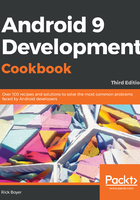
上QQ阅读APP看书,第一时间看更新
How it works...
This is a very straightforward exercise but it demonstrates several of the RelativeLayout options: layout_centerVertical, layout_centerHorizontal, layout_below, layout_alignParentBottom, and so on.
The most commonly used RelativeLayout layout attributes include the following:
- layout_below: This View should be below the View specified.
- layout_above: This View should be above the View specified.
- layout_alignParentTop: Align this View to the top edge of the parent.
- layout_alignParentBottom: Align this View to the bottom edge of the parent.
- layout_alignParentLeft: Align this View to the left edge of the parent.
- layout_alignParentRight: Align this View to the right edge of the parent.
- layout_centerVertical: Center this View vertically within the parent.
- layout_centerHorizontal: Center this View horizontally within the parent.
- layout_center: Center this View both horizontally and vertically within the parent.
For the complete list of RelativeLayout parameters, visit http://developer.android.com/reference/android/widget/RelativeLayout.LayoutParams.html.